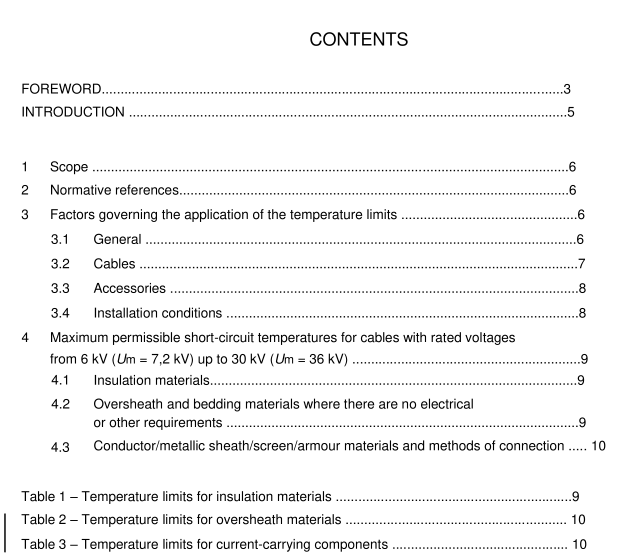IEC 60986 pdf – Short-circuit temperature limits of electric cables with rated voltages from 6 kV (U m = 7,2 kV) up to 30 kV (U m = 36 kV)

IEC 60986 pdf – Short-circuit temperature limits of electric cables with rated voltages from 6 kV (U m = 7,2 kV) up to 30 kV (U m = 36 kV)
1 scope
This International Standard gives guidance on the short-circuit maximum temperature limits ofelectric cables having rated voltages from 6 kV(Um = 7,2 kV) up to 30 kv(Um = 36 kV), withregard to the following:
insulating materials;
oversheath and bedding materials;
– conductor and metallic sheath materials and methods of connection.
The design of accessories and the influence of the installation conditions on the temperaturelimits are taken into consideration.
The calculation of the permissible short-circuit current in the current-carrying components ofthe cable should be carried out in accordance with IEC 60949.
Normative references
The following referenced documents are indispensable for the application of this document. Fordated references, only the edition cited applies.For undated references, the latest edition ofthe referenced document (including any amendments) applies.
IEC 60055(all parts), Paper-insulated metal-sheathed cables for rated voltages up to 18/30 kv(with copper or aluminium conductors and excluding gas-pressure and oil-filed cables)
IEC 60141(all parts), Tests on oil-filled and gas-pressure cables and their accessoriesIEC 60502-2:1998, Power cables with extruded insulation and their accessories for ratedvoltages from 1 kV(Um = 1,2 kV) up to 30 kV(Um = 36 kV) – Part 2: Cables for rated voltagesfrom 6 kv(Um = 7,2 kv) up to 30 kv(Um = 36 kv)
IEC 60949:1988,Calculation of thermally permissible short-circuit currents, taking into accountthe non-adiabatic heating effects
3Factors governing the application of the temperature limits
3.1 General
The short-circuit temperatures given in clause 4 are the actual temperatures of the current-carrying component as limited by the adjacent material in the cable and are valid for short-circuit durations of up to 5 s. When calculating the allowable short-circuit current, thesetemperatures will be obtained if heat loss into the insulation during the short-circuit is takeninto account (non-adiabatic heating). If heat loss during the short-circuit is neglected (adiabaticheating), the calculations give short-circuit currents that are on the safe side.
NOTE The temperature limits given in clause 4 should also not be exceeded with repeated short-circuits occurringin a short time.
The 5 s time period mentioned is the limit for the temperatures quoted to be valid and not forthe application of the adiabatic calculation method.The time limit for the use of the adiabaticmethod has a different definition, being a function of both the short-circuit duration and thecross-sectional area of the current-carrying component.This is dealt with in lEC 60949.
The short-circuit temperature limits recommended in this standard are based on theconsideration of the range of limits used by various authorities. They are not necessarily
the ideal values as very little applicable experimental data are available on actual cables.Thevalues are, however, considered to be on the safe side.
The limits for cables in this standard are selected so that the dielectric properties are notimpaired.The impairment of dielectric properties will be very dependent on the type of cable,for example adhesion of the semi-conducting screens will most likely set the limits for
polymeric insulated cables, whereas the properties of the dielectric itself are of moreimportance in paper cables (both oil-filled and mass-impregnated cables).
Caution may be needed when using the conductor temperatures specified when the cables aresheathed with a lower temperature material, especially for cables with conductor cross-
sectional areas of 1 000 mm and above. This is because the high thermal time constant of
these cables will cause the oversheath to attain high temperatures for longer times. In addition,the high mechanical forces could result in insulation deformation.Nevertheless, it should bestressed that for conductor cross-sectional areas above 1 000 mm , the permissible short-circuit current is so high that it is not normally attained in common systems.
Where other temperature limits are known with certainty to be more appropriate for thematerials or the cable design,then these may be used.
3.2Cables
3.2.1 Paper insulated cables (both oil-filled cables according to lEC 60141 and
mass-impregnated cables according to lEC 60055)
The temperature limits for paper insulated cables impregnated with oil/resin or non-drainingcompound are imposed by the tendency to compound migration and void formations. All paperinsulated cables are also limited by thermal degradation of the cable components and by
possible tearing of paper tapes due to movement of the cores.









